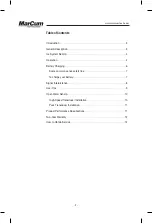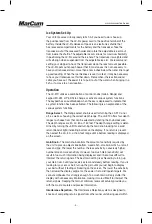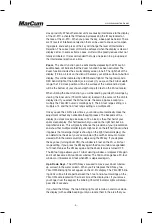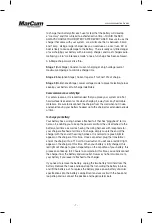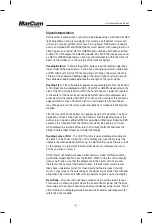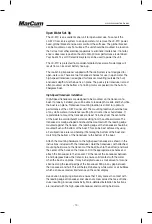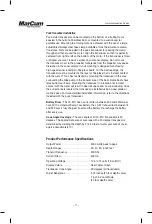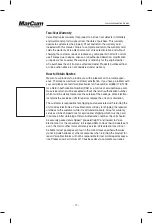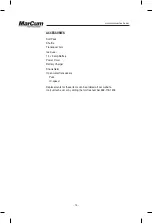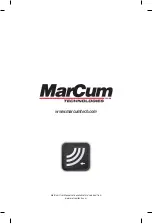
www.marcumtech.com
- 7 -
to charge their battery after each use for fear that the battery will develop
a “memory” and this will lead to a shortened run time—THIS IS FALSE!!!
ALWAYS CHARGE YOUR BATTERY AFTER EVERY USE!!! Be sure to use the
charger that came with your system, or a similar one that is between .5 amp
and 1 amp. Using a larger charger, like you would use on a car, truck, RV, or
boat is likely to cause damage to the battery. There is really very little danger
of overcharging your battery with a low amp charger, and most chargers auto-
matically go into “maintenance mode” once a full charge has been achieved.
A 3-Stage charger works like this—
Stage 1 (Bulk Stage): Constant current charging at a high voltage level at
maximum amperage to minimize charge time.
Stage 2 (Absorption Stage): Current tapers off for final 10% of charge.
Stage 3 (Maintenance Stage): Lower voltage mode to prevent electrolyte loss,
keeping your battery at full charge indefinitely.
Some common sense safety tips:
For safety reasons, it is recommended that you place your system on a flat,
hard surface like cement or tile when charging it, away from any flammable
materials. Be sure to disconnect the charger from the wall when not in use,
and avoid leaving your battery hooked up to the charger for extended periods
of time.
To charge your battery:
Your battery has a wiring harness attached to it that has “piggyback” termi-
nals on it, enabling you to keep the power cord from the unit attached to the
battery at all times, as well as having the wiring harness with receptacle for
your charger attached at all times. To charge, simply couple the end of the
charger with the end of the wiring harness. It is normal for a green light to
appear on the charger at this time. Once connected, plug the transformer
end of the charger into a 110 volt AC wall outlet. You will see a red LED light
appear on the charger at this time. When your battery is fully charged, this
red light will change to green. Depending on the condition of your battery, this
process can take up to 20 hours to complete. At this time, you can disconnect
the charger from the battery and wall outlet. However, no harm will come to
your battery if you leave it attached to the charger.
If you need to remove the battery, unplug the two battery terminals from the
battery. Remove the hook and loop strap that is holding the battery in place
and lift the battery out. To replace the battery, place a new battery of similar
specifications into the battery compartment and secure it with the hook and
loop strap and re-connect the positive and negative terminals.


